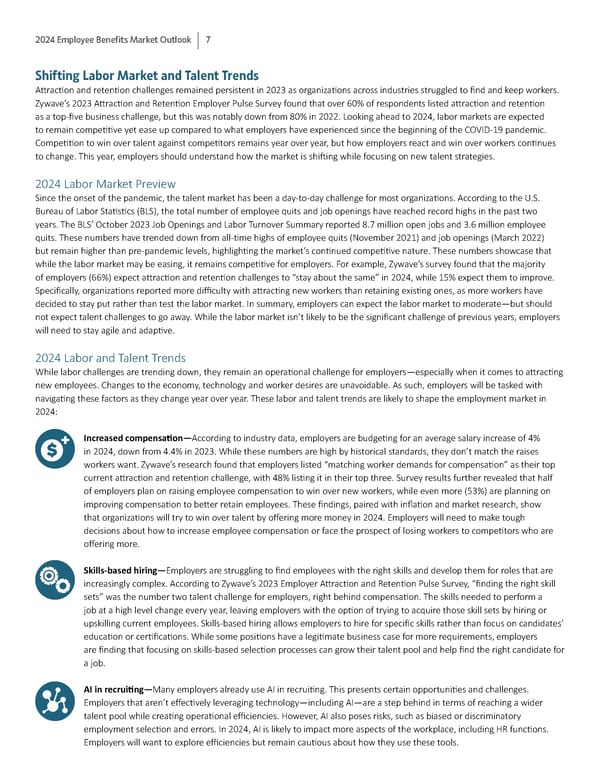2024 Employee Benefits Market Outlook 7 Shifting Labor Market and Talent Trends A琀琀rac琀椀on and reten琀椀on challenges remained persistent in 2023 as organiza琀椀ons across industries struggled to 昀椀nd and keep workers. Zywave’s 2023 A琀琀rac琀椀on and Reten琀椀on Employer Pulse Survey found that over 60% of respondents listed a琀琀rac琀椀on and reten琀椀on as a top-昀椀ve business challenge, but this was notably down from 80% in 2022. Looking ahead to 2024, labor markets are expected to remain compe琀椀琀椀ve yet ease up compared to what employers have experienced since the beginning of the COVID-19 pandemic. Compe琀椀琀椀on to win over talent against compe琀椀tors remains year over year, but how employers react and win over workers con琀椀nues to change. This year, employers should understand how the market is shi昀琀ing while focusing on new talent strategies. 2024 Labor Market Preview Since the onset of the pandemic, the talent market has been a day-to-day challenge for most organiza琀椀ons. According to the U.S. Bureau of Labor Sta琀椀s琀椀cs (BLS), the total number of employee quits and job openings have reached record highs in the past two years. The BLS’ October 2023 Job Openings and Labor Turnover Summary reported 8.7 million open jobs and 3.6 million employee quits. These numbers have trended down from all-琀椀me highs of employee quits (November 2021) and job openings (March 2022) but remain higher than pre-pandemic levels, highligh琀椀ng the market’s con琀椀nued compe琀椀琀椀ve nature. These numbers showcase that while the labor market may be easing, it remains compe琀椀琀椀ve for employers. For example, Zywave’s survey found that the majority of employers (66%) expect a琀琀rac琀椀on and reten琀椀on challenges to “stay about the same” in 2024, while 15% expect them to improve. Speci昀椀cally, organiza琀椀ons reported more di昀케culty with a琀琀rac琀椀ng new workers than retaining exis琀椀ng ones, as more workers have decided to stay put rather than test the labor market. In summary, employers can expect the labor market to moderate—but should not expect talent challenges to go away. While the labor market isn’t likely to be the signi昀椀cant challenge of previous years, employers will need to stay agile and adap琀椀ve. 2024 Labor and Talent Trends While labor challenges are trending down, they remain an opera琀椀onal challenge for employers—especially when it comes to a琀琀rac琀椀ng new employees. Changes to the economy, technology and worker desires are unavoidable. As such, employers will be tasked with naviga琀椀ng these factors as they change year over year. These labor and talent trends are likely to shape the employment market in 2024: Increased compensa琀椀on—According to industry data, employers are budge琀椀ng for an average salary increase of 4% in 2024, down from 4.4% in 2023. While these numbers are high by historical standards, they don’t match the raises workers want. Zywave’s research found that employers listed “matching worker demands for compensa琀椀on” as their top current a琀琀rac琀椀on and reten琀椀on challenge, with 48% lis琀椀ng it in their top three. Survey results further revealed that half of employers plan on raising employee compensa琀椀on to win over new workers, while even more (53%) are planning on improving compensa琀椀on to be琀琀er retain employees. These 昀椀ndings, paired with in昀氀a琀椀on and market research, show that organiza琀椀ons will try to win over talent by o昀昀ering more money in 2024. Employers will need to make tough decisions about how to increase employee compensa琀椀on or face the prospect of losing workers to compe琀椀tors who are o昀昀ering more. Skills-based hiring—Employers are struggling to 昀椀nd employees with the right skills and develop them for roles that are increasingly complex. According to Zywave’s 2023 Employer A琀琀rac琀椀on and Reten琀椀on Pulse Survey, “昀椀nding the right skill sets” was the number two talent challenge for employers, right behind compensa琀椀on. The skills needed to perform a job at a high level change every year, leaving employers with the op琀椀on of trying to acquire those skill sets by hiring or upskilling current employees. Skills-based hiring allows employers to hire for speci昀椀c skills rather than focus on candidates’ educa琀椀on or cer琀椀昀椀ca琀椀ons. While some posi琀椀ons have a legi琀椀mate business case for more requirements, employers are 昀椀nding that focusing on skills-based selec琀椀on processes can grow their talent pool and help 昀椀nd the right candidate for a job. AI in recrui琀椀ng—Many employers already use AI in recrui琀椀ng. This presents certain opportuni琀椀es and challenges. Employers that aren’t e昀昀ec琀椀vely leveraging technology—including AI—are a step behind in terms of reaching a wider talent pool while crea琀椀ng opera琀椀onal e昀케ciencies. However, AI also poses risks, such as biased or discriminatory employment selec琀椀on and errors. In 2024, AI is likely to impact more aspects of the workplace, including HR func琀椀ons. Employers will want to explore e昀케ciencies but remain cau琀椀ous about how they use these tools.
 2024 Employee Benefits Market Outlook Page 6 Page 8
2024 Employee Benefits Market Outlook Page 6 Page 8